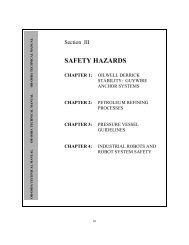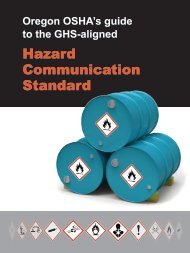Asbestos - Rules of Abatement - Oregon OSHA
Asbestos - Rules of Abatement - Oregon OSHA
Asbestos - Rules of Abatement - Oregon OSHA
Create successful ePaper yourself
Turn your PDF publications into a flip-book with our unique Google optimized e-Paper software.
Work classification<br />
<strong>Oregon</strong> <strong>OSHA</strong>’s standard establishes a classification system for asbestos<br />
construction work that clearly spells out work practices that reduce worker<br />
exposures. Four classes <strong>of</strong> construction activity are matched with control<br />
requirements. 1<br />
Class I asbestos work, the most hazardous class <strong>of</strong> asbestos jobs, involves the<br />
removal <strong>of</strong> asbestos-containing or presumed asbestos-containing thermal<br />
insulation and sprayed-on or troweled-on surfacing material.<br />
Thermal insulation includes asbestos-containing materials applied to pipes,<br />
boilers, tanks, ducts, or other structural components to prevent heat loss or<br />
gain. Surfacing materials may include decorative plaster on ceilings, acoustical<br />
materials on decking, or firepro<strong>of</strong>ing on structural members.<br />
Class II work includes the removal <strong>of</strong> other types <strong>of</strong> asbestos-containing<br />
materials that are not thermal insulation, such as flooring and ro<strong>of</strong>ing materials.<br />
Removing intact incidental ro<strong>of</strong>ing materials such as cements, mastics, coatings,<br />
and flashings is not regulated as Class II. Examples <strong>of</strong> Class II work<br />
include removal <strong>of</strong> floor or ceiling tiles, siding, ro<strong>of</strong>ing, or transite panels.<br />
When a designated competent person deems ro<strong>of</strong>ing material being removed as<br />
intact, the ro<strong>of</strong>ing contractor may make a negative exposure assessment and<br />
avoid initial monitoring if both the following conditions are met:<br />
1. Employees have been trained.<br />
2. The work practices described in the rule are strictly followed.<br />
Class III asbestos work includes repair and maintenance operations where<br />
asbestos-containing or presumed asbestos-containing materials are disturbed.<br />
The primary purpose <strong>of</strong> the work is not to remove or disturb asbestos, although<br />
some removal or disturbance may occur. Examples <strong>of</strong> Class III work include<br />
repairing broken pipes that have asbestos wrapping, installing floor anchors in<br />
an area with asbestos floor tile, or installing electrical conduit through walls<br />
with asbestos insulation.<br />
Class IV operations include maintenance and custodial activities in which<br />
employees contact but do not disturb asbestos-containing materials. These<br />
activities must be related to the construction project, usually resulting from<br />
Class I, II, or III activities. Custodial work that is not related to a construction<br />
project or to Class I, II, or III work is covered by the general industry asbestos<br />
rule, OAR 437-002-1910.1001.<br />
DEQ/LRAPA rules approach asbestos exposure in a different manner. Recognizing<br />
that public exposures may not be as easily definable, and following the<br />
<strong>Oregon</strong> Legislature’s mandate that there is no safe level <strong>of</strong> exposure, DEQ/<br />
LRAPA crafted rules expressly to prevent or eliminate exposures to the public<br />
and the environment. To that end, the DEQ/LRAPA asbestos rules require<br />
1<br />
See Appendix, pages 28-31, for a list <strong>of</strong> provisions by work classification.
















